|
|
Starting Over |
February 2004 |
|
Given how many hours you spend in your recording studio, it's worth the time and the thought ĺ─ţ and a few extra dollars ĺ─ţ to make it a space you enjoy working in. After all, there's more to designing a studio than just choosing its equipment.
Whether you are moving to a new place or gutting and completely redesigning your existing studio, the design considerations are mostly the same. So start the process by imagining that you have just moved into a new space and are planning the studio layout from scratch. That's what contributing editor Larry the O did when researching this month's cover story, ĺ─˙Planning Your Ideal Recording Spaceĺ─¨ (see p. 40).
In his article, Larry discusses how to plan the various parts of your studio redesign. In this editorial, I want to offer an overall philosophy for your studio-design process that complements Larry's approach. (I presented this information in more depth in ĺ─˙Holistic Studio Design,ĺ─¨ published in the 1999 Personal Studio Buyer's Guide, which newer EM readers probably missed.)
In my view, the key to the design process is to think of your studio as a single, integrated instrument. To design it properly, you should analyze your needs and plan how the elements will integrate into a functional unit before you install anything or buy additional gear. Think of your studio as a holistic system that has a structure: an organized arrangement of parts. Each part has a function and occupies a ĺ─˙statusĺ─¨ ĺ─ţ power supply, acoustic conditioning, controller, effects processor, sound source, and so on. Pay special attention to the relationships between the parts.
Having defined your objectives, you should analyze your production methods so you can identify how you like to work. Based on your objectives and working style, consider which functions are necessary to achieve your goals. For instance, are you using only electronic sound sources or will you record acoustic instruments and vocals, including guest artists? Do you like to use a lot of outboard hardware (implying a need for cables, patch bays, and AC power distribution) or mostly software?
Next, decide whether your system will remain static (other than adding software) or dynamic (with gear coming and going). If dynamic, you not only need to allow physical space for new gear, you also should figure out convenient and sufficient AC power and preconfigured audio and MIDI patch bays for quick and easy connections. Compatibility and connectivity are major issues, even in a static studio. But they are paramount in our holistic design, so pay special attention to them.
Studio security also should be part of your plan, and Michael Cooper offers some eminently practical security advice in ĺ─˙Working Musician: Don't Get Ripped Off!ĺ─¨ on p. 96.
Perhaps these ideas seem obvious, but I have visited many personal studios and have often been dismayed by flaws that clearly reflected poor planning and a lack of integration. The next time I visit your studio, though, I am confident I'll see a well-integrated facility reflecting a holistic design. |
